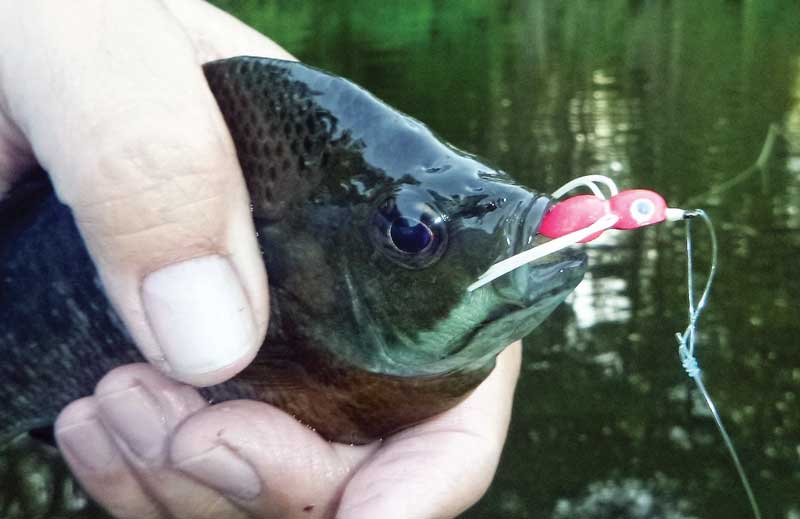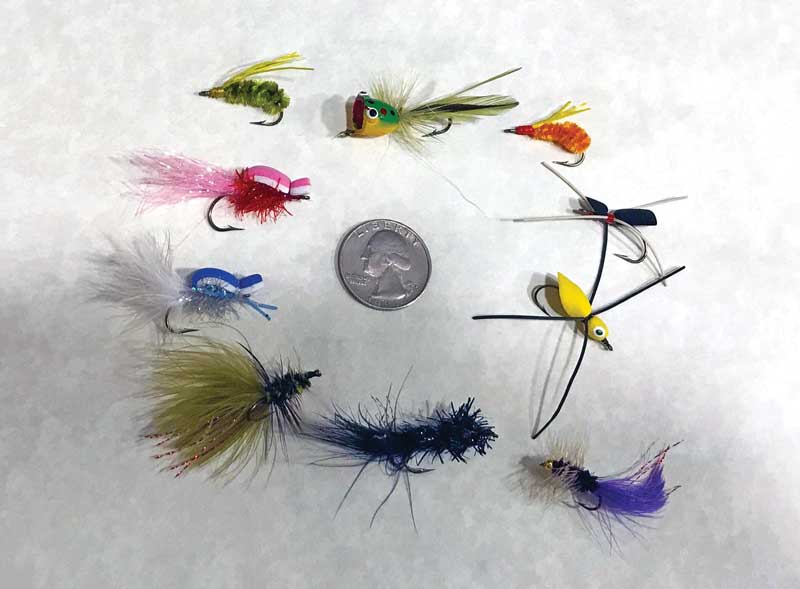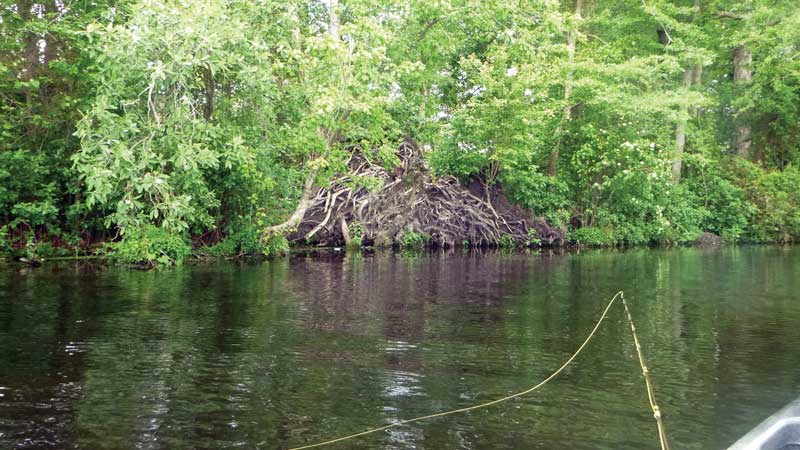Small and feisty, bluegills get little respect from hardcore anglers. They’re by-catches for many seeking their next five-pound bass. Or they’re a target fish for your grandchildren who are dangling garden worms under a bobber as you introduce them to fishing. In some places they’ve become a nuisance. Sent to Japan as a gift from the U.S. in the 1960s, they have overpopulated freshwaters and been designated an invasive species—the Japanese version of a snakehead.

But warmwater fly anglers know better. We relish the opportunity to catch these aggressive, colorful sunfish on both topwater and subsurface flies. We know that a spring outing on a pond or tidal creek can yield nonstop bluegill action on our three-, four-, and five-weight fly rods. Plus, an eight to nine-inch bluegill can put quite a bend in our rods. They fight far above their weight.
Bluegill catches on the fly increase when water temperatures reach 60 to 65 degrees—magic water temperature for bluegill action. Central Maryland waters typically reach that temperature in late April. Peak bluegill spawning will occur through late May, and in some local waters, especially Eastern Shore ponds, bluegills reproduce the entire summer. At those times, the males, awash in their most regal colors of orange, purple, blue, and black, will head to shallow water only several feet deep where they will excavate a small crater on sand or gravel bottoms. That location becomes their domicile, their honeymoon suite, and eventually their nursery.
Female bluegills are attracted to the largest and most colorful males who steadfastly guard their saucer-shaped homes. They enter his home willingly, nuptials ensue, and then the male chases the female away. Yes, the male bluegill is a single parent. He protects the nest and eggs as they hatch which can take up to a week. He continues to guard the nest until the babies are big enough to swim away. That can be another 10 days.
However, not all male bluegills are as noble as the nest-builders I mentioned above. Smaller and younger males do not build nests. They wait nearby and crash the honeymoon suite of a nest builder! That means a single bluegill nest may contain eggs fertilized by two or more males. Some of the nest-building males will actually remove the eggs fertilized by the cad male visitor. Others do not mind sharing their genetics with smaller males.
After laying eggs and being chased from the scene, the female bluegill is not finished with her spawn. She looks for another suitable male. She will visit multiple nests during the spawning season, and she may lay up to 80,000 eggs during the year.

Given such prolific spawning, it is easy to see how bluegill populations can overwhelm a pond without sufficient predation. They can pose a problem for fisheries managers trying to maintain a healthy balance among various species in a body of water. On the other hand, they are critical links in the food chain. Delaware, for example, will stock immature three-inch bluegills into their ponds to create forage for bass.
So, why are bluegills good fly rod targets once water temperatures reach 60 degrees? The answer is simple. Their overwhelming desire to procreate brings them to our reach. Even though bluegills thrive in northern waters, they are not active when water temperatures drop. As summer ends and water cools in the fall, they depart from the shallows. They descend to deeper waters where their metabolisms slow significantly. They do not eat much. They hover together in schools throughout the winter. But in spring and summer, warming waters and longer daylight hours flip their metabolic switches into active mode. The males stake out territories and build nests. The females roam these nests and they do so throughout the summer. All this requires energy and that means bluegills are hungry.
Added to their insatiable hunger is the fact that male bluegills are vigilantly guarding their nests from predators—especially the threats we pose with our fly rods. Our small foam spiders, poppers, and wooly buggers are invasive in their eyes and must be removed. Males will chase, slap their tails at, or bite any foreign object near their nests.
Hence, spring and summer bluegills are great practice for beginning fly anglers learning how to cast, retrieve their flies, and set the hook. The first catch on a fly rod for many anglers was a bluegill. And many fly anglers, even after they have mastered trout and other freshwater and tidal fish species on the fly, return to bluegills as a warm water pursuit.
Fly casting for bluegills is terrific fun from shore or from a kayak or canoe. A kayak or canoe will provide access to more water than shore angling. The shallow draft of such vessels allows anglers to quietly approach the common areas where bluegills reside in spring through summer with no wake to disturb them. Again, flyrods in the three-, four-, or five-weight range with a floating line and an eight to nine-foot tapered monofilament leader are ideal in chasing these rambunctious fish. Then it is a just a matter of presenting the fly to them.

A bluegill is not a picky eater. There is no need to “match the hatch” of emerging insects as a trout angler must do. A bluegill will succumb to any reasonable representation of a spider or water beetle or even a small frog. Flies in hook sizes six to 10 made of foam in a multitude of colors that float on the water’s surface serve this purpose every well.
Bluegills will also hit subsurface flies that imitate minnows or other aquatic lifeforms. Flies of this type sink slowly into the feeding zone of bluegills. Again, small hooks in sizes six to 10 are best. Wooly buggers are a classic fly for bluegills. They may represent a leech, caterpillar, or even small crayfish to a bluegill. In fact, any small sinking buggy looking fly will produce a good session of bluegill action.
The best approach is to cast the fly to a shallow shaded shoreline area, two to four feet deep, and to let it sit momentarily without moving it. For surface flies, a curious bluegill may come up to inspect the intruder. Often, they will study the fly before they decide to attack it. They may look at it for five or 10 seconds. If your patience holds that long, they will likely strike your offering. But if you want to encourage a bite, just twitch the fly slightly, not hard. After that subtle movement, the indecisive bluegill will odds-on engulf the fly. The same process works for subsurface flies. Let them sink slowly before retrieving them. And then, as they near the bottom, twitch them slightly. A bluegill will not chase a fly far. They need to see it, inspect it, and make a deliberate decision to strike. Slow, patient fly retrievals by the fly angler will be rewarded.
Avid Maryland flyrodders know that a late spring or summer session on quiet waters will produce nonstop action from bluegills. They appreciate everything these fish offer anglers from their willingness to bite a variety of flies, their big fight in a small package, and their beautiful colors. In addition, bluegills are ubiquitous. They populate small ponds, large impoundments, and the upper reaches of tidal creeks. Indeed, these energetic fish are found in waters only minutes away from most Marylanders. Fly anglers in particular hold them in very high esteem—an honor these little fish well deserve.
About the Author: Mark Bange is a member of the Free State Fly Fishers and author of “Fly by the Seat of Your Kayak: A Guide to Simplified Kayak Flyfishing in Tidal Creeks and Freshwater Ponds” and “The Simple Joys of Kayak Fishing.” Both books are available on Amazon.